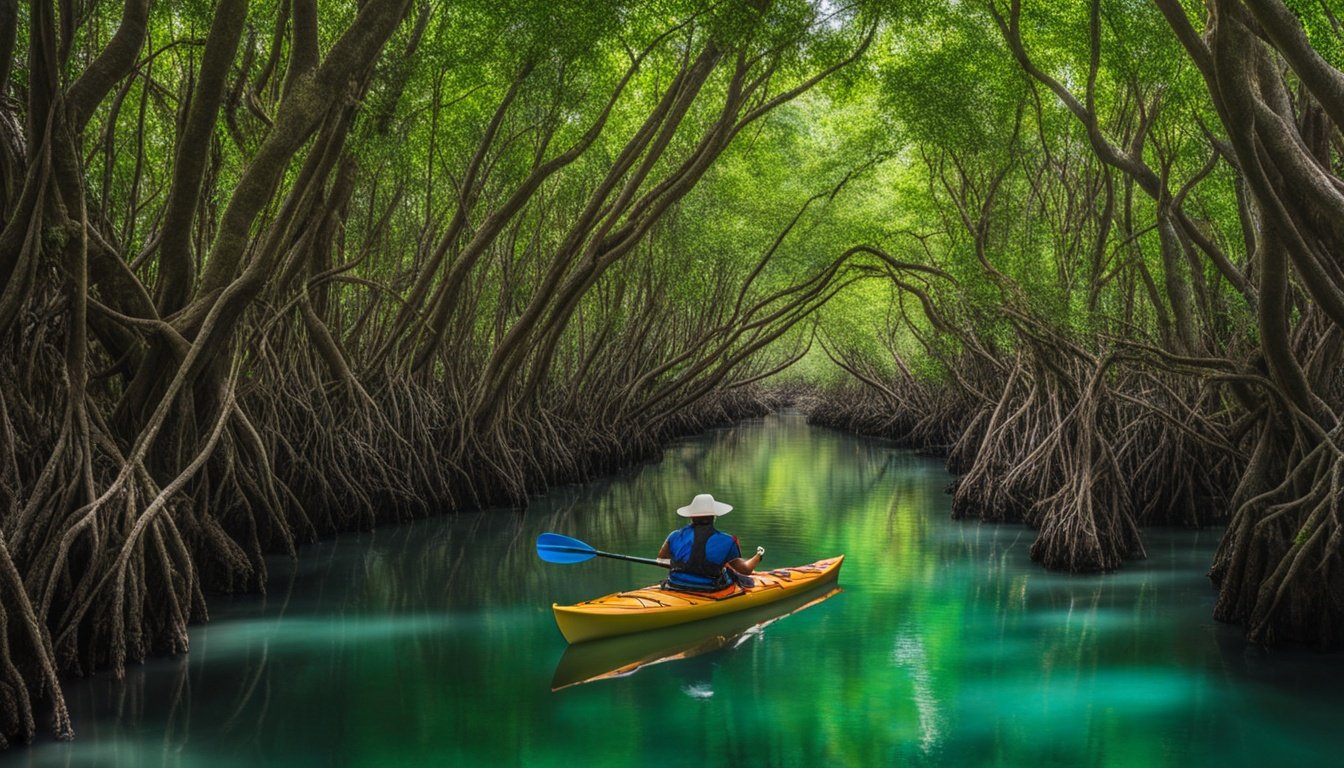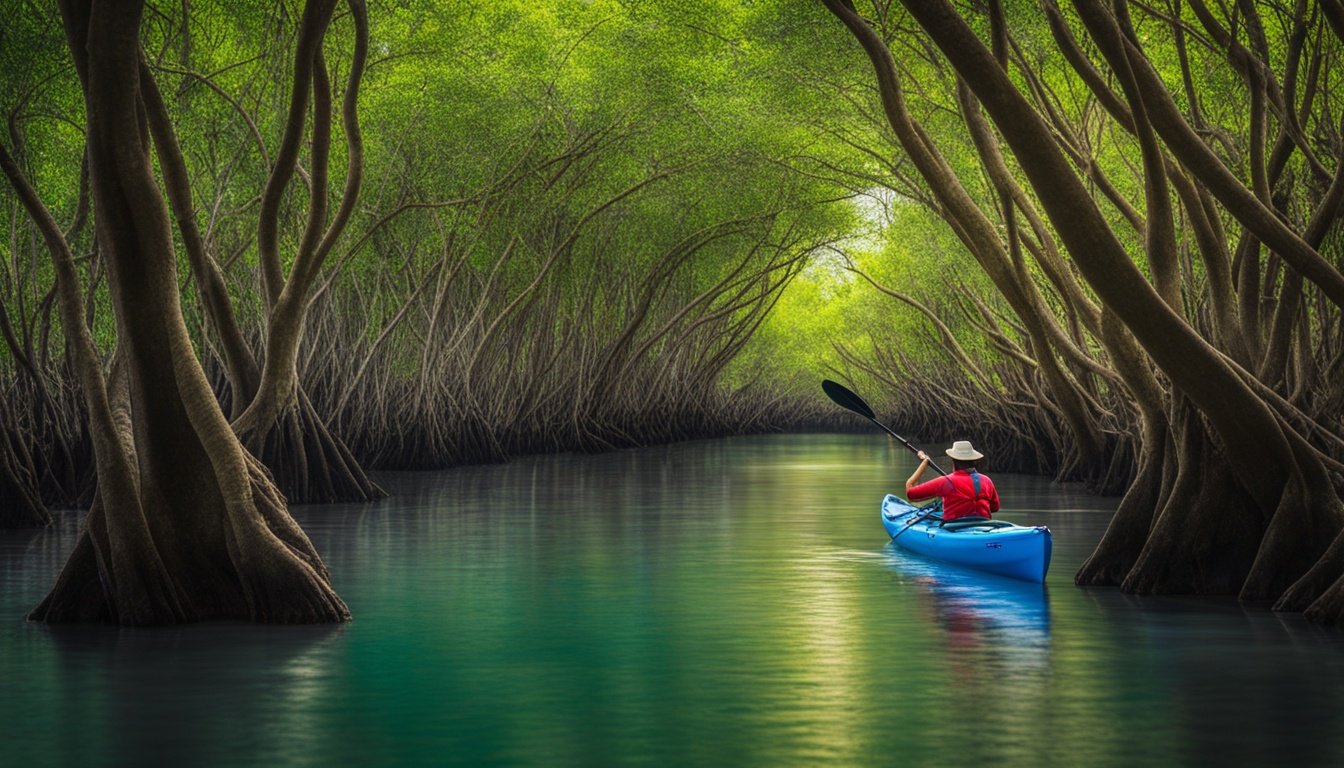Ever wondered what’s behind the lush mangrove forests along the Philippines’ coasts? Join a kayaking adventure in Pangasinan to explore its stunning coastal ecosystems. Discover Pangasinan’s coastal ecosystems and the secrets of these vibrant habitats and the amazing life they support.
Pangasinan, in northern Luzon, boasts 124 islands over 1,844 hectares of clear waters. This area is rich in nature and history, perfect for eco-tourism. Dive into this underwater world and see how mangrove forests protect this unique region.
Key Takeaways
- Explore the 124 islands that make up Pangasinan’s expansive coastal ecosystem, covering over 1,844 hectares of azure sea.
- Discover the history and significance of the Hundred Islands National Park, established in 1940 by President Manuel Quezon.
- Witness the collaborative efforts of the government and local communities to protect and manage Pangasinan’s coastal resources.
- Embark on a unique kayaking adventure through the region’s lush mangrove forests, surrounded by diverse wildlife and natural beauty.
- Gain a deeper appreciation for the ecological importance of mangrove ecosystems in safeguarding coastlines and supporting biodiversity.
Understanding Mangrove Forests
Mangroves are special coastal wetland forests in tropical and subtropical areas. These trees and shrubs live in salty or brackish water, with roots that hold them in place. They are a key part of coastal ecosystems, protecting against storms, preventing soil loss, and cleaning pollutants from the water.
What are Mangroves?
Mangroves are plants that grow in the area between land and sea. They have special roots that stick out of the water to breathe and hold the soil. These forests are in quiet coastal spots, estuaries, and lagoons. They create a dense, complex environment that supports many different kinds of life.
Ecological Significance of Mangroves
- Mangroves protect coastal areas from storms, waves, and erosion.
- They are important homes and breeding places for many sea creatures, helping local communities.
- Mangroves help fight climate change by storing a lot of carbon.
- Their roots keep the shoreline stable, preventing soil from washing away.
- They clean the water by removing pollutants and extra nutrients, keeping the coast healthy.
Benefits of Mangrove Forests
Mangrove forests are great for the environment and people. They offer many benefits, including:
- They provide timber and charcoal.
- They are homes for many animals, including rare ones.
- They are nurseries for fish and shellfish that are important for food.
- They protect the coast from storms and erosion.
- They clean and purify the water.
- They help fight climate change by storing carbon.
These benefits show why it’s important to protect and manage mangrove forests well. This helps both nature and people.
“Mangroves are the most efficient coastal ecosystem for carbon sequestration, with the potential to store up to four times more carbon than tropical rainforests.”
Kayaking Through Mangroves: A Unique Experience
Kayaking is the top way to see the amazing mangrove ecosystems of Pangasinan. As you move quietly through the green waters, you’ll get close to the mangrove trees and their complex roots. You’ll also see the many animals that live in these coastal areas.
Why Kayaking is the Best Way to Explore Mangroves
Kayaking gives you a special view that bigger boats can’t match. It lets you go through narrow channels and shallow waters that are off-limits to larger boats. This close-up view of the mangrove forests shows you the details and secrets that are usually missed.
What to Expect During a Mangrove Kayaking Adventure
- Encounter a wide range of birds, fish, and other marine creatures in their natural habitats
- Admire the intricate network of mangrove roots that create a maze-like waterway
- Observe the lush, green foliage and the interplay of light and shadow within the mangrove canopy
- Gain a deeper appreciation for the importance of these vital coastal ecosystems
- Enjoy a peaceful, serene, and eco-friendly nature adventure in the heart of the mangrove forests
Whether you love adventure or just want a unique outdoor experience, kayaking in the mangrove forests of Pangasinan is unforgettable. Dive into the natural beauty and take part in a kayak through mangroves, explore the mangrove ecosystems, and embark on a truly memorable mangrove kayaking experience.
“Kayaking through the mangroves is like stepping into a hidden, magical world – you’ll be surrounded by the intricate roots, vibrant greenery, and the peaceful sounds of nature. It’s an experience that truly connects you with the environment.”
Best Mangrove Kayaking Spots in Pangasinan
Pangasinan is a province in the northern Philippines known for its amazing mangrove kayaking spots. Visitors can see lush waterways and the rich life of these coastal areas. The Camotes Island Mangrove Swamp Forest Reserve is a top spot for mangrove kayaking.
Another great place is the Poro-San Francisco Mangrove Highway. It connects Poro Island to San Francisco/Pacijan Island. Here, kayakers can paddle through calm waters and see many mangrove species like talisay, pandan, and agoho trees.
Camotes Island Mangrove Swamp Forest Reserve
The Camotes Island Mangrove Swamp Forest Reserve is huge, covering much of the Camotes coast. Kayakers can move through the greenery and see many mangrove species. It’s a special place.
Poro-San Francisco Mangrove Highway
The Poro-San Francisco Mangrove Highway is perfect for mangrove kayaking in Pangasinan. It links Poro and San Francisco/Pacijan Islands to the unique mangrove forests along the coast. Kayakers can enjoy the calm waters and see the mangrove ecosystem‘s plants and animals.
| Mangrove Kayaking Spot | Location | Unique Features |
|---|---|---|
| Camotes Island Mangrove Swamp Forest Reserve | Camotes Islands, Pangasinan | Vast expanse of mangrove forests covering a significant portion of the Camotes coastline |
| Poro-San Francisco Mangrove Highway | Poro Island to San Francisco/Pacijan Island, Pangasinan | Scenic waterway connecting the islands, providing easy access to unique mangrove forests |
The Camotes Island Mangrove Swamp Forest Reserve and the Poro-San Francisco Mangrove Highway are great for mangrove kayaking. They let you see the amazing mangrove ecosystems of Pangasinan. These best mangrove kayaking spots are perfect for pangasinan eco-tourism adventures and guided mangrove kayaking tours.

Tips for Kayaking in Mangroves
Kayaking through the beautiful mangrove forests of Pangasinan is an adventure. It’s important to follow safety tips and eco-friendly practices. This way, you can have a safe and sustainable trip through this unique coastal area.
Safety Precautions and Tips
- Always wear a properly fitted life jacket to ensure your safety in the water.
- Be aware of tidal changes and weather conditions, and plan your excursion accordingly.
- Familiarize yourself with the proper paddling techniques and maneuvers to navigate the mangrove channels safely.
- Inform someone of your itinerary and expected return time before setting out.
Equipment Rental and Purchase
Many local tour operators and outdoor outfitters in Pangasinan offer equipment rental and guided tours. They provide the gear and knowledge you need to explore the mangrove waterways responsibly. Using these resources makes your kayaking experience smooth and fun.
Environmental Conservation and Responsible Practices
When kayaking through the mangrove forests, keep it eco-friendly. Don’t disturb wildlife, dispose of waste properly, and support conservation efforts. By doing this, you help protect Pangasinan’s coastal environments for the future. Responsible tourism helps preserve these unique ecosystems.
“Protecting the mangrove forests is not just an environmental imperative, but a crucial step towards ensuring the future of sustainable tourism in Pangasinan.” – Eco-tourism expert, Jane Doe
Wildlife Encounters
Pangasinan’s mangrove forests are full of different animals, from birds to sea creatures. As you kayak, you might see birds like the Philippine duck and brahminy kite. You might also see fish and sea creatures like sea urchins and starfish under the water.
Common Mangrove Forest Species
In Pangasinan, the mangrove forests are home to many animals. You might see:
- Birds: Philippine duck, brahminy kite, egrets, herons, and various migratory birds
- Fish: Parrotfish, clownfish, mullet, and various reef fishes
- Invertebrates: Sea urchins, starfish, crabs, and mollusks
Observing Mangrove Wildlife Responsibly
When you visit the mangrove forests, be respectful and careful. Keep your distance from animals and make little noise. This way, you help protect these important places and enjoy the beauty of nature.
| Wildlife in Pangasinan Mangrove Forests | Key Characteristics |
|---|---|
| Philippine Duck | A resident waterfowl species found in the mangrove forests and wetlands of Pangasinan. Known for its distinctive plumage and adaptations to the coastal environment. |
| Brahminy Kite | A raptor species commonly observed soaring over the mangrove canopy, hunting for prey and scavenging in the coastal areas. |
| Parrotfish | Vibrant reef fish that play a crucial role in maintaining the health of the mangrove ecosystem by grazing on algae and contributing to the formation of coral sand. |

“Responsible wildlife viewing is essential to protecting the delicate balance of the mangrove ecosystem and ensuring the continued survival of its diverse inhabitants.”
By being respectful and careful, you can enjoy the beauty of Pangasinan’s mangrove forests. You’ll get to see wildlife without disturbing them. This helps protect these special places for the future.
Mangrove Conservation Efforts
Protecting Pangasinan’s mangrove forests is crucial for the region’s ecological balance and coastal resilience. Local groups and organizations are working hard to save these vital ecosystems. They know how important mangroves are for controlling floods, preventing erosion, storing carbon, and supporting marine life.
Importance of Mangrove Conservation
Mangrove forests are huge carbon sinks, taking in four times more carbon than rainforests. They also help control floods and erosion, provide homes for marine life, and support coastal communities. It’s vital to protect and manage these resources well to keep Pangasinan’s coasts resilient.
Local Initiatives and Organizations Involved in Mangrove Conservation
In Pangasinan, many local groups and organizations are working on mangrove conservation. The Camotes Island Mangrove Swamp Forest Reserve shows their dedication to sustainable management. By supporting these efforts and choosing eco-friendly tourism, visitors can help protect Pangasinan’s mangroves.
| Indicator | Value |
|---|---|
| Mangrove Cover in Subic Bay Freeport Zone | 61.63 hectares |
| Mangrove Rehabilitation in Subic Bay Freeport Zone | 26,000 propagules replanted with 90% survival rate in 1.33 hectares |
| Entrance Fee for Sabang Mangrove Forest Tour | ₱350 ($7) per person |
| Tree Planting Certificate Price at Sabang Mangrove Forest | ₱5 ($0.096) |
Thanks to these efforts and local organizations, Pangasinan is doing well in managing its mangrove ecosystems. This ensures they last a long time and keep giving back to the community.
“Mangrove forests act as colossal carbon sinks, absorbing 4 times more carbon than rainforests or any other ecosystems.”
Conclusion
Pangasinan’s mangrove forests are a must-see for those who love nature and eco-tourism. Places like the Camotes Island Mangrove Swamp Forest Reserve and the peaceful Poro-San Francisco Mangrove Highway are perfect for exploring. These areas show off the beauty and diversity of the Philippines.
Going kayaking in these mangrove waterways lets you see how important these places are for nature. You’ll learn about the local community’s efforts to protect them. As you find the top spots for kayaking in Pangasinan, you’ll see why these mangroves are so vital.
Tourism that respects nature is key to keeping these places safe. By visiting Pangasinan’s mangrove forests, you help protect them. Your visit supports the work to keep these areas beautiful for the future.
